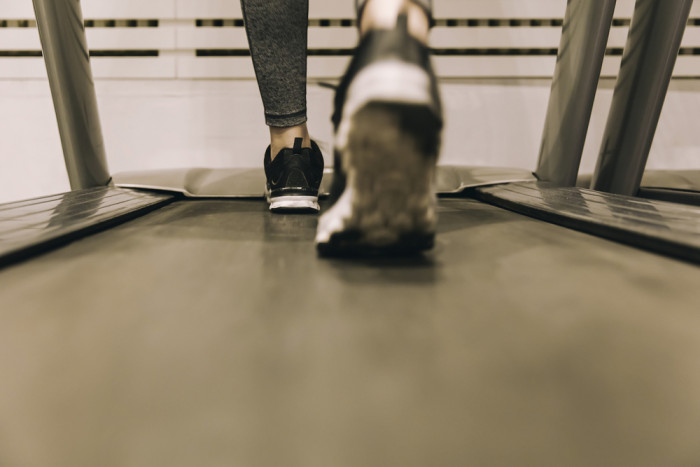I Just Want to Be Strong

BGStock72/Shutterstock
I’m in the gym, on minute 17 of the stair-stepper machine, exhausted and desperately watching the timer count up to 20. That’s today’s goal: nonstop stepping on levels five and six for 20 minutes.
This session is bookended by a 10-minute treadmill warmup and cooldown to get my heart rate up. Proper breathing escalation means I’ll be able to complete the routine without gasping for air like a fish stranded on the shoreline.
I don’t pay attention to the calories burned because that’s irrelevant. Timing, though helpful to structure the routine, also doesn’t matter for my purposes. I’ve already settled on an objective that hasn’t changed in years: I want to build strength.
Next to me, a tan woman in hip athletic leggings begins her timer. She starts at level seven as if it’s her warmup, and only increases from there. Her musculature is clearly defined, and she doesn’t even appear to break a sweat.
“Mind your business,” I tell myself. “Her fitness is not your fitness. Her story is not yours.”
I don’t have a classic thin physique, and no one would describe me as athletic at first glance. But I am strong. Early in life, I learned the hard way that this is the greater priority.
Flashback: It’s 2005, and I’m a teenager in a hospital bed, where I’ve been confined for the past three weeks after severe onset of vasculitis. A physical therapist brings me a weighted ball and asks me to raise it over my head. Shockingly, I find I can’t even lift the ball off my lap — I had spent 12 days in an induced coma and my muscles had atrophied. The ball weighs only 1 pound.
There will be multiple instances in the coming weeks when my mind and body feel incongruous. Once I can get out of bed, I put on a pair of shorts, and am horrified to see someone else’s leg protruding from them. Except it’s not someone else’s leg — it’s mine. I’ve lost 20 pounds and need to sit down from the effort of dressing myself. My own body won’t be recognizable to me for months to come.
Back in the current-day scenario at the gym, it feels as though I’m functioning in a different world than the other humans surrounding me. Plenty of people are attempting to change their look for vanity’s sake — trying for a thinner, more fit, or somehow different shape, an enviable physique in one way or another. Their pursuit is mainly cosmetic.
The woman on the adjacent treadmill might be working to cut down on what she’s told by a magazine are “problem areas.” The college kid might be striving to thicken his frame so he can look better at the next pool party. The guy with the bulging biceps might be an actual bodybuilding competitor, for all I know. But those same types probably have no idea what it feels like to struggle to lift a 1-pound ball.
I don’t need to look good. I just want to be strong.
To vasculitis patients, strength is more than muscle ability. It includes a certain level of bone density, something that was affected in the early stages of my illness. (Physicians often prescribe steroids to vasculitis patients to control inflammation that unfortunately wears down a patient’s bone health, along with myriad other difficult side effects.)
Strength is also the coordination of my bones, joints, and muscles so that I can get around smoothly, cultivate good balance, and become more risk-averse to injury. Cardio serves to strengthen my heart, so that on days when I can’t complete a full exercise session, I know my organs are functioning well.
The goal of strength affects not only my health status, but also my career. As a professional musician, there are countless parallels between stage performance and sports.
My late 20s brought remission, but also the reality that my body was aging. Long practice sessions made for a stiff right shoulder, neck, and shoulder blade. Orchestra concerts nearly always introduced back pain. Even standing on the hardwood floor of my studio space for an hour made my feet ache. These were bothersome enough to compel me to begin resistance training.
For my career or my chronic illness (usually both), those steps on the machine at the gym are for me and only me. I look down and focus on my feet climbing, one after the other, repeatedly, to reach that 20-minute mark. Strength is undoubtedly mental and psychological. But at its core, it is physical, a numbers game of pounds, or lifts, or percentages — so I’ve learned not to care about the digits themselves, except where they show upward progress.
“You did it,” I tell myself afterward. “You’re strong. Great work today.”
***
Note: ANCA Vasculitis News is strictly a news and information website about the disease. It does not provide medical advice, diagnosis, or treatment. This content is not intended to be a substitute for professional medical advice, diagnosis, or treatment. Always seek the advice of your physician or other qualified health provider with any questions you may have regarding a medical condition. Never disregard professional medical advice or delay in seeking it because of something you have read on this website. The opinions expressed in this column are not those of ANCA Vasculitis News or its parent company, Bionews, and are intended to spark discussion about issues pertaining to ANCA vasculitis.






Walter Gerdenits
Stay strong and keep pushing. I am with You in spirit.
Walt.
Josephine Jakobi
I was diagnosed with Q fever a few years ago. Although blood tests show that I no longer have any live bacteria, symptoms persist. My GP is unable to help me any further. I saw a Facebook post recently that mentioned a link between Q fever and Vasculitis. The description sounds very like what happens to me, so I am interested in knowing more.
Rolando Lacuata
I hope fda will approve avacopan for people like us.I never lost hope that someday there will a cure for vasculitis.
John A Wall
It's the simple things, right? I've started back at the gym myself, just trying to get strong enough to not feel weak. Diagnosed with GPA 5 yrs ago (at age 61), still frustrated with what my body can no longer do. Hopes and prayers to you.
tricia Michaels
I was diagnosed at 62 with GPA and retired had retire the week before as I could not reliably show up at work. I was a NICU RN and Lactation Consultant. Now, I found out I could join a gym free due to my Medicare Advantage Plan and tonight did a modified class where I struggled with balance, strength and breath as I now have 70% lung function. I will see how my body feels tomorrow after minor exercise over the last 4 years. I have walked my dogs, played with grand-kids and swam in the summer. Stay strong! This is actually inspiring!